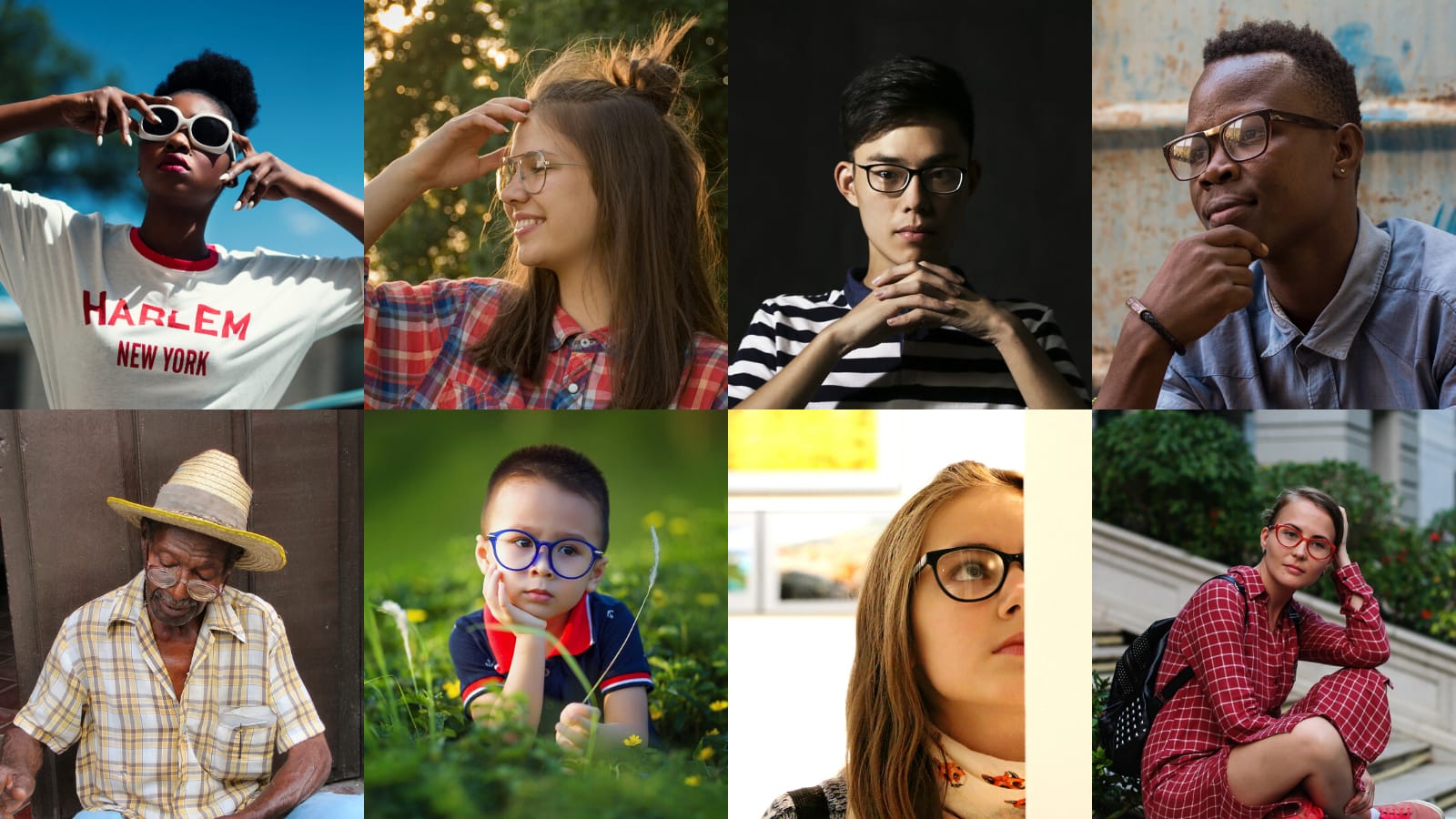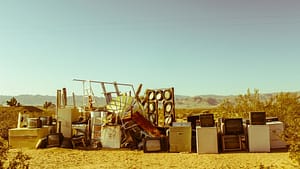Growing up, my grandmother desperately needed glasses—she couldn’t even see the doorknob. But she would always hide them, choosing to memorize patient charts in nurses’ training instead of wearing her glasses in front of the doctors. These days though, people are desperate for cool eyewear. So, how did this medical device become fashionable? And could other physical aids could become personality “statements”?
About 65% of American adults wear prescription eyewear, and one out of every four children has a vision problem. 1 Glasses are, at their core, a medical aid. Without them, many people wouldn’t be able to drive, read, or function independently. And yet, unlike so many other medical aids, they have made the leap to a fashion accessory.
How did this happen? And could the world of glasses potentially push innovation and acceptance for other assistive technologies like hearing aids or prosthetic limbs?

Eyewear, it’s Everywhere! A Brief History of Glasses…
Nowadays, glasses say a lot about a person: what they do, their socioeconomic status, even the group of people they associate themselves with. In all this style, we can easily forget that the history of glasses started over 700 years ago as a very functional and practical tool.
Glasses have been revolutionized from sun-shields made of bone (yes, you read that right), to reading stones, and eventually to the glasses we know and love today! To understand how they made the transition from practical tool to iconic fashion staple we have to take a look at the history of glasses.
So. throw on your favorite shades (or keep on your reading glasses!), you’re about to see the impact of eyewear in an entirely new way. And maybe, discover how we can transform the design for other aids, as well! Here’s Debbie Millman, a writer and designer, and host of the podcast, Design Matters.
This video is from a great series by TED called Small Thing Big Idea. The series takes a look at everyday objects like the coffee cup lid, buttons, and number 2 pencils, revealing the ways these simple, ubiquitous parts of our life have transformed the world in their own ways!
We’ve featured a few of them in our articles. You can check them below, or (and I highly suggest you do) head over to explore their full archive on the TED Website.
The Surprising Genius Behind Your To-Go Cup!
There’s a little piece of history sitting right on top of the to-go cup of coffee you grabbed today. The coffee cup lid may seem like a humble piece of human innovation, but it’s got a secret history!
Read Article Watch Video Listen to PodcastCan Your Buttons Change the Way You Look at the World?
It’s a simple innovation but the button is one of many small wonders we see every day. So what is it that makes the button so special, and could learning about it make us happier, maybe even come up with the next small wonder? It can!
Read Article Watch Video Listen to PodcastTransforming the way we see the world!
“Wouldn’t it be wonderful if anything that we use—any device that we’ve invented to help our humanity— could also be elevated in the same way.”
—Debbie Millman
Think about the way society treats eyeglasses versus the way it treats hearing aids or prosthetic limbs. It makes you start to think: “Why are these worlds so different?”
What would happen if we opened up the world of technologies like hearing aids, prosthetic limbs, and wheelchairs to the world of design the way glasses have been? We could spur on innovation in these areas, too! Turning these items designed to help us thrive into a form of artistic and personal expression.
Why are glasses perceived differently?
While I was doing some research for this piece, I found this incredible interview from the Atlantic with thought leader Sarah Hendren. She specializes in thinking about the overlap between design, adaptive technologies, and prosthetics. For eight years, she ran a blog called Abler, where she explored and wrote about the overlap of art, adaptive technologies and prosthetics, as well as the future of human bodies and the built environment.
In the interview, I read something that profoundly changed the way I think about the world of adaptive technologies:
“Assistive technologies” have largely taken their points of departure from medical aids, primarily because in industrialized cultures, people with atypical bodies and minds have been thought of as medical “cases,” not as people with an expanded set of both capacities and needs. So a lot of the design attention to things like crutches, wheelchairs, hearing aids, and the like have followed the material look and structure of hospital gear. And accordingly, designers and people working in tech have “read” them as a branch of medical technologies and, usually, uninteresting.
Scholars and people who are activists for disability rights have spent a lot of energy in the last decades showing that disability is not about the state of a human body; it’s about the built environment, structures, and institutions that make life possible and meaningful—or conversely, impossible and meager—for certain kinds of bodies and minds. In other words, disability studies have worked to transition an understanding of disability from a “medical model” to a “social model.” A social model of disability opens up the discussion to consider how design and technologies might be re-imagined for all kinds of bodies, not “assigned” to those with medicalized conditions.
By returning “assistive technology” to its rightful place as just “technology”—no more, no less—we start to understand that all bodies are getting assistance, all the time. And then design for everyone becomes much more interesting. 3
“People with atypical bodies and minds have been thought of as medical ‘cases,’ not as people with an expanded set of both capacities and needs.” What a truly profound statement.
So, how does this expand possibility for us all?
What if— as she points out some activists are doing—we saw disability, not as a problem with the people but a problem with the environment people are in. Somebody who needs a wheelchair isn’t limited by a disability in this way of thinking. No, instead, what’s limiting them is the potential of their wheelchair or limited by the potential of stairs and other obstacles.
Now, let’s bring this back to glasses. Think about Sarah Hendren’s words in terms of glasses: one of the most widely used and ubiquitous forms of assistive technology. When glasses moved out of the world of medical devices, they could be opened up to any number of design and fashion innovations! And, now, there are even people who don’t have the need for glasses seeking out fashionable frames.
What’s possible if we move other technologies that help people into this world of open innovation?
Here are just a few of the possibilities we’ve written about here at the Goodness Exchange:
A Beautiful Look at the Future of Eldercare!
It’s time to break the mold on what eldercare looks like! Where would you want to spend your golden years? How about a village complete with a bar, shopping center, and living catered to your lifestyle! This is a leap for us all!
Read Article Watch Video Listen to PodcastMeet The Company Making Travel Accessible for Everyone!
Trekking up Machu Pichu, exploring Easter Island, navigating through the wilds of Mexico; these were all trips once impossible for travelers who use wheelchairs. But this organization is changing all of that!
Read Article Watch Video Listen to PodcastAsparagus: A New Treatment for Spinal Cord Injuries?
A feeling very familiar to most of us almost kept this life-changing treatment for spinal cord injuries from making it to testing! Here’s how Andrew Pelling and his fellow researchers overcame self-doubt to create this breakthrough innovation.
Read Article Watch Video Listen to PodcastCreating a world that doesn’t limit any body opens up a remarkable world of better design for everyone.
Our lack of imagination about the rigidity of how things are or “should be” keeps us from innovating in new and exciting ways.
So, the next time you put on your glasses, remember how that piece of technology has unleashed a world of possibility. And think to yourself how that same mindset could unleash a world of opportunity for others as well!
Stay beautiful & keep laughing!
-Liesl

Don’t miss out on a single article!
Enjoy unlimited access to over 500 articles & podcast that give you a positive perspective on the state of the world and show you practical ways you can help.
Notes:
- MESVision. “VISION FACTS AND STATISTICS.” 2007. https://www.mesvision.com/includes/pdf_Broker/MESVision%20Facts%20and%20Statistics.pdf. Accessed 2/18/2020. ↩
- TED. “The Function and Fashion of Eyeglasses | Small Thing Big Idea, a TED Series.” YouTube, 2020, www.youtube.com/watch?v=eeVCz-9SUc8&feature=emb_title. Accessed 18 Feb. 2020. ↩
- Rosen, Rebecca J. “None.” The Atlantic, The Atlantic, 3 Dec. 2013, www.theatlantic.com/technology/archive/2013/12/why-are-glasses-perceived-differently-than-hearing-aids/282005/. Accessed 18 Feb. 2020. ↩








